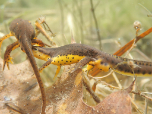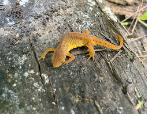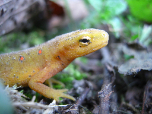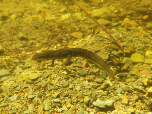|
Eastern Newt (Notophthalmus viridescens)
Description: Eastern newts grow to be 2.5-5 inches long. They are yellow or greenish-brown with black-bordered red spots on their backs and lighter, yellow bellies with black spots. They have slightly moist, rough skin. This species generally has three distinct life stages: aquatic larvae, terrestrial juvenile (or eft) and aquatic adult. In the larval stage, eastern newts have smoother olive green skin, narrow tails and feathery external gills. During this stage, they can only live in water. After two to five months, they develop into a terrestrial eft that is brighter orange-red in color. The eft's lungs, legs and eyelids make it more suited for life on land. Newts may travel great distances to new water sources during this time, making their homes in leaf litter along the way.
Generally, efts metamorphose into aquatic adults after two to three years; however, some populations remain in the eft stage permanently, only entering pools to breed. Examples of newts that reached sexual maturity while maintaining their external gills, called neotenic newts, have also been reported. As aquatic adults, eastern newts can survive on land.
Habitat: Eastern newts are at home in both coniferous and deciduous forests. They need a moist environment with either a temporary or permanent body of water, and thrive best in a muddy environment. Eastern newts have a preference for certain types of habitats, with males preferring more open, aquatic habitats and females preferring more forested, terrestrial habitats. This preference may be related to the different roles that males and females play in the reproductive process, with males typically being more active in courtship and females spending more time on land preparing to lay eggs.
They may travel far from their original location during the eft stage. Red efts may often be seen in a forest after a rainstorm. Adults prefer a muddy aquatic habitat, but will move to land during a dry spell. Eastern newts have some amount of toxins in their skin, which is brightly colored to act as a warning. Even then, only 2% of larvae make it to the eft stage. Some larvae have been found in the pitchers of the carnivorous plant Sarracenia purpurea.
Range: This species can be found throughout the eastern United States of America and adjacent southern Canada; west to Minnesota, eastern Kansas, and eastern Texas.
Diet: Eastern newts are carnivorous, feeding on a variety of prey every two to three days. As larvae, they feed on small aquatic invertebrates, and as adults, they eat insects, worms, snails, and other small invertebrates. Eastern newts eat a variety of prey, such as insects, springtails, soil mites, small mollusks and crustaceans, young amphibians, worms, and frog eggs. They also eat a lot of snails, beetles, ants, and mosquito larvae, with an annual ingestion of about 35,000 kcal. Their dietary habits prove to be beneficial to humans because they help to control insect populations and maintain balance to their habitats. Eastern newts are a vital part of many ecosystems, serving as both predators and prey.
Reproduction: Eastern newts breed once per year, when breeding starts in late fall until early spring. They are known to be polygynandrous, with females and males mating with multiple partners. Males have preference towards larger females, while no evidence for female preference during mating was found. The breeding migration often happens more with rainfall. The male's spots attract females, luring them to him with fanning motions of his tail, causing a pheromone to be released. Once the female has chosen a mate, the male will deposit a spermatophore, a package of sperm, onto the ground, which the female will then pick up and fertilize her eggs with. The female will lay her eggs in the water, attaching them to submerged vegetation or other objects. 200~400 eggs are laid in a single batch, with incubation period of 3~8 weeks. For the normal and healthy development of gonads, fat-bodies are needed in proximity of the developing organs to ensure proper reproduction ability.
Status: Listed as Least Concern in view of its wide distribution and number of subpopulations, presumed large population size, and remaining suitable habitat across its range.
»» Kingdom: Animalia - Animals
»» Phylum: Chordata - Chordates
»» Subphylum: Vertebrata - Vertebrates
»» Class: Amphibia - (Amphibians)
»» Order: Caudata - Salamanders
»» Family: Salamandridae - Newts
»» Subfamily: Pleurodelinae - Pleurodeline Newts
»» Genus: Notophthalmus
»» Species: Notophthalmus viridescens - Eastern Newt
This article uses material from the Wikipedia article "Eastern Newt", which is released under the Creative Commons Attribution-Share-Alike License 3.0. Content may have been omitted from the original, but no content has been changed or extended.
|
|







